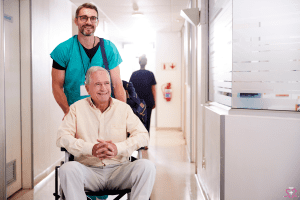The Benefits of Physical Therapy
The Benefits of Physical therapy is a cornerstone of rehabilitation and recovery. It is a dynamic profession with an established theoretical and scientific base.
The practice of physical therapy encompasses a broad spectrum of specialties. These include orthopedic, neurological, pediatric, geriatric, cardiopulmonary, and pelvic floor therapy.
Physical therapy offers a range of benefits. It can improve mobility, manage pain and chronic conditions, and enhance overall wellness.
This article delves into the myriad benefits of physical therapy. It provides an in-depth exploration of the various types of physical therapy available.
We will also discuss the role of physical therapy in the management of different health conditions. This includes its impact on post-surgical recovery and chronic disease management.
The article will also highlight the role of physical therapy professionals, who guide patients through their recovery journey.
This article will provide valuable insights whether you are a healthcare professional, a potential patient, or simply interested in the field.
Join us as we explore the benefits of physical therapy and its significant role in healthcare.
The Historical Evolution and Definition of Physical Therapy
Physical therapy, also known as physiotherapy, has a rich history dating back to ancient times. The practice has evolved significantly over the centuries, with advancements in medical knowledge and technology shaping its development.
In its essence, physical therapy is a healthcare profession that assesses, diagnoses and treats individuals with conditions that limit their ability to move and perform functional activities. The goal is to restore, maintain, and promote optimal physical function, wellness, and quality of life.
Physical therapy professionals, also known as physical therapists or physiotherapists, are integral to this process. They utilize various therapeutic techniques, assistive devices, and patient education strategies to facilitate recovery and prevent future injury. The profession is grounded in science and evidence-based practice, ensuring patients receive the most effective and appropriate care.
Explore Senior Care ServicesThe Multifaceted Role of Physical Therapy in Healthcare
Physical therapy is multifaceted in healthcare, serving as a critical component of patient care across various settings. It is instrumental in rehabilitation and recovery, helping individuals regain their strength, mobility, and function after an injury, surgery, or illness.
Physical therapists work closely with patients, their families, and other healthcare professionals to develop comprehensive treatment plans. These plans are designed to address each patient’s unique needs and goals, promoting optimal recovery and long-term health.
Physical therapy plays a significant role in rehabilitation and prevention. Physical therapists provide education and interventions to prevent injuries, manage chronic conditions, and promote overall health and wellness.
Moreover, physical therapy can also reduce the need for long-term use of prescription medications, including opioids, by managing pain more effectively. This is particularly important given the current opioid crisis and the associated risks of addiction and overdose.
Types of Physical Therapy
Several types of physical therapy are designed to address specific health needs.
Orthopedic physical therapy focuses on the musculoskeletal system and treats conditions such as sprains, fractures, and arthritis. Neurological physical therapy helps individuals with neurological disorders like stroke, Parkinson’s disease, and multiple sclerosis.
Pediatric physical therapy assists in the early detection of health problems and uses a variety of interventions to treat disorders in the pediatric population. Geriatric physical therapy aims to reduce pain, improve mobility, and help older adults maintain independence.
Cardiopulmonary physical therapy is designed for those with cardiopulmonary disorders or those who have had cardiac or pulmonary surgery. Lastly, pelvic floor physical therapy can help manage conditions related to bowel incontinence, constipation, and pelvic pain.
Each type of physical therapy requires specialized knowledge and skills to provide effective and safe patient care.
Individualized Treatment Plans
A cornerstone of physical therapy is the development of individualized treatment plans. These plans are tailored to each patient’s specific needs and goals, considering their health history, physical abilities, and lifestyle.
Physical therapists collaborate closely with patients, involving them in decision-making to ensure that the therapy aligns with their personal goals and expectations. This collaborative approach fosters a sense of ownership and engagement in the patient, significantly enhancing the effectiveness of the treatment.
Moreover, these individualized plans are dynamic and are regularly reviewed and adjusted based on the patient’s progress and changing needs. This ensures that the therapy remains relevant and practical throughout treatment, reassuring patients that their unique needs and goals are being met.
The Impact of Physical Therapy on Pain Management and Opioid Reduction
Physical therapy plays a crucial role in pain management, offering a non-pharmacological alternative to opioids. It employs various techniques to alleviate pain, improve mobility, and enhance quality of life.
Physical therapists use a combination of manual therapy, therapeutic exercises, and other interventions to manage pain. These techniques address the symptoms and target the underlying causes of pain, providing long-term relief.
Moreover, physical therapy can help reduce the need for opioids, which are often prescribed for pain management. While opioids can be effective in the short term, they carry significant risks, including addiction and overdose. By offering an effective alternative, physical therapy can play a crucial role in addressing the opioid crisis.
Furthermore, physical therapy can also help those who are already dependent on opioids. By managing their pain more effectively, it can support their efforts to reduce or eliminate their use of these drugs.
Manual Therapy Techniques
Manual therapy is a critical component of physical therapy. It involves hands-on techniques to improve tissue extensibility, increase range of motion, induce relaxation, mobilize or manipulate soft tissues and joints, modulate pain, and reduce soft tissue swelling, inflammation, or restriction.
Techniques may include manual lymphatic drainage, joint mobilization, neuromuscular techniques, muscle energy techniques, and soft tissue mobilization. These techniques can be particularly effective in managing musculoskeletal pain, including back pain, neck pain, and pain associated with arthritis.
Moreover, manual therapy can also enhance the effectiveness of other physical therapy interventions. For instance, it can improve the outcomes of therapeutic exercises by increasing joint mobility and reducing pain.
Therapeutic Exercises
Therapeutic exercises are another critical component of physical therapy. These exercises are designed to restore or improve physical function, reduce pain, and prevent disability.
Depending on the patient’s needs, therapeutic exercises may focus on improving strength, flexibility, endurance, balance, or coordination. They may also include functional training to help patients perform tasks or activities they find difficult.
Moreover, therapeutic exercises can also be crucial in managing chronic conditions. For instance, they can help manage the symptoms of arthritis, fibromyalgia, and other chronic conditions, improving the patient’s quality of life and reducing their reliance on medication.
Physical Therapy for Chronic Conditions and Fall Prevention
Physical therapy is a vital tool in managing chronic conditions. It can help patients manage their symptoms, improve their function, and enhance their quality of life.
For instance, physical therapy can help manage the pain, stiffness, and reduced mobility associated with arthritis. It can also help patients with fibromyalgia manage their symptoms and improve their physical function.
Moreover, physical therapy can also play a crucial role in fall prevention, particularly among older people. Falls are a leading cause of injury among older adults, and physical therapy can help reduce their risk.
Chronic Conditions Management
Physical therapy can be particularly effective in managing chronic musculoskeletal conditions, such as arthritis and fibromyalgia. It can help reduce pain, improve mobility, and enhance physical function.
For instance, physical therapists can combine manual therapy, therapeutic exercises, and other interventions to manage arthritis symptoms. These interventions can help reduce joint stiffness, improve range of motion, and enhance the patient’s ability to perform daily activities.
Moreover, physical therapy can also help manage the symptoms of fibromyalgia, a chronic condition characterized by widespread pain, fatigue, and cognitive difficulties. Physical therapists can use various techniques to help manage pain, improve physical function, and enhance the patient’s quality of life.
Fall Prevention Strategies
Physical therapy can play a crucial role in fall prevention, particularly among older adults. Improving balance, strength, and mobility can help reduce the risk of falls.
For instance, physical therapists can use balance training exercises to help improve the patient’s stability and reduce their risk of falls. They can also provide education on fall prevention strategies, such as modifying the home environment.
Moreover, physical therapy can also help manage the consequences of falls. For instance, it can help patients recover from fall-related injuries, such as fractures, and regain their mobility and independence.
Explore Senior Care ServicesTechnological Advancements and Evidence-Based Techniques in Physical Therapy
Significant advancements in technology and evidence-based techniques in physical therapy have improved the effectiveness of treatments and expanded the scope of conditions that can be managed.
For instance, integrating telehealth services has made physical therapy more accessible. It has allowed patients to receive treatment from the comfort of their homes, reducing the need for travel and making it easier for them to adhere to their treatment plans.
Moreover, innovations such as virtual reality have opened up new possibilities for treatment. They have allowed more engaging and effective therapies, particularly for mobility and coordination conditions.
The Integration of Telehealth Services
Telehealth services have revolutionized the delivery of physical therapy. They have allowed patients to receive treatment from the comfort of their homes, reducing the need for travel and making it easier for them to adhere to their treatment plans.
For instance, physical therapists can use videoconferencing tools to conduct assessments, provide treatments, and monitor their patients’ progress. They can also use digital platforms to provide education and support, enhancing the effectiveness of their treatments.
Moreover, telehealth services have also made physical therapy more accessible. They have enabled patients in remote or underserved areas to receive high-quality physical therapy services, reducing health disparities and improving health outcomes.
Virtual Reality and Other Innovations
Virtual reality is one of the most exciting innovations in physical therapy. It has opened up new possibilities for treatment, particularly for conditions that affect mobility and coordination.
For instance, physical therapists can use virtual reality to create immersive, interactive environments to help patients improve their balance, coordination, and strength. These environments can be tailored to each patient’s needs, making the treatments more engaging and effective.
Moreover, virtual reality can simulate real-world activities, helping patients regain their functional abilities. For instance, it can simulate walking or climbing stairs, assisting patients restore mobility and independence.
The Psychological and Quality of Life Benefits of Physical Therapy
Physical therapy is not just about improving physical health. It also has significant psychological benefits, significantly enhancing a patient’s quality of life.
For instance, physical therapy can help patients manage chronic pain, which can have a significant impact on their mental health. By reducing pain, physical therapy can help patients feel more comfortable and improve their mood.
Moreover, physical therapy can also help patients regain their independence. This can boost their self-esteem and improve their overall well-being.
Finally, physical therapy can also help patients cope with the psychological impact of their conditions. It can provide them with the tools and strategies they need to manage their symptoms and improve their quality of life.
Mental Health Improvements
Physical therapy can have a significant impact on mental health. For instance, it can help patients manage chronic pain, which can have a substantial effect on their mood and overall well-being.
Physical therapy can help patients feel more comfortable by reducing pain. This can improve their mood and make them feel more positive.
Moreover, physical therapy can also provide patients with the tools and strategies they need to cope with the psychological impact of their conditions. This can help them manage their symptoms and improve their mental health.
Enhancing Quality of Life
Physical therapy can significantly enhance a patient’s quality of life. For instance, it can help patients regain independence, boosting their self-esteem and overall well-being.
Physical therapy can help patients perform their daily activities more efficiently by improving mobility and function. This can make them feel more confident and improve their quality of life.
Moreover, physical therapy can also help patients manage their symptoms and cope with their conditions. This can reduce their stress and anxiety, enhancing their quality of life.
The Economic and Societal Advantages of Physical Therapy
Physical therapy offers significant economic benefits. It can reduce healthcare costs by minimizing the need for expensive surgeries and long-term medication use.
Moreover, physical therapy can help patients return to work faster after an injury or illness, reducing the economic burden on the individual and society as a whole.
Physical therapy also plays a crucial role in preventing injuries and chronic diseases. Promoting healthier lifestyles can reduce the overall burden on the healthcare system.
Finally, physical therapy can improve individuals’ quality of life and have positive societal implications. It can help individuals lead more productive and fulfilling lives.
Reducing Healthcare Costs
Physical therapy can significantly reduce healthcare costs. It can minimize the need for expensive surgeries and long-term medication use.
For instance, physical therapy can help patients recover from injuries without surgery. It can also help manage chronic conditions, reducing the need for ongoing medication.
Moreover, by helping patients return to work faster, physical therapy can reduce the economic burden on the individual and society, resulting in significant cost savings for the healthcare system.
Case Studies and Patient Testimonials
Numerous case studies and patient testimonials highlight the benefits of physical therapy. These stories provide real-world evidence of its impact on individual lives.
For instance, many patients have reported significant improvements in their mobility and function after undergoing physical therapy. They have been able to return to their daily activities and lead more fulfilling lives.
Moreover, many patients have also reported improvements in their mental health. They have noted that physical therapy has helped them cope with the psychological impact of their conditions, improving their overall well-being.
Conclusion: The Future of Physical Therapy and Patient-Centered Care
Physical therapy is a dynamic and evolving field. It continues to adapt to the changing needs of patients and the healthcare system.
The future of physical therapy lies in its ability to provide patient-centered care. This involves understanding and addressing each patient’s unique needs and goals.
Moreover, integrating technology and evidence-based practices will continue to shape the future of physical therapy. These advancements will enhance the effectiveness and efficiency of physical therapy interventions.
Finally, physical therapy’s role in promoting health and wellness will continue to grow. It will be crucial in preventing injuries and chronic diseases, improving the population’s overall health.
The Role of Research and Policy in Physical Therapy
Research plays a crucial role in advancing the field of physical therapy. It provides the evidence needed to develop effective and efficient treatment strategies.
Moreover, research can help identify patients’ needs and preferences, which can inform the development of patient-centered care models in physical therapy.
Policy also plays a significant role in shaping the practice of physical therapy. It can influence the accessibility and affordability of physical therapy services, impacting patients’ health outcomes.
Emphasizing Patient-Centered Care
Patient-centered care is at the heart of physical therapy. It involves understanding and addressing each patient’s unique needs and goals.
Physical therapists work closely with patients to develop individualized treatment plans that are tailored to each patient’s specific condition, abilities, and goals.
Moreover, patient-centered care involves empowering patients to take an active role in their treatment. This can improve adherence to treatment plans and enhance the effectiveness of physical therapy interventions.
















